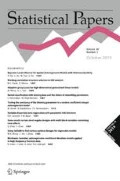Abstract
A geometrical approach is considered to the problem of discriminating between any two multivariate normal populations, in particular, those with unequal variance matrices. This approach guarantees the existence of a linear discriminant function and provides a simple algorithm to derive the equation of this line. A numerical example is provided.
Similar content being viewed by others
References
Anderson, J. A. (1975) “Quadratic logistic discrimination,”Biometrika,26: 149–154.
Anderson, T. W., & Bahadur, R. R. (1962) “Classification into multivariate normal distributions with different covariance matrices,”Annals of Mathematical Statistics 33: 420–431.
Fisher, R. A. (1936) “The use of multiple measurement in taxonomic problems,”Annals of Eugenics 7: 179–188.
Kendall, Sir M. G. (1975)Multivariate Analysis. Hafner Press, New York.
Srivastava, M. S., & Khatri, C. G. (1979)An Introduction to Multivariate Statistics, North Holland, New York.
Author information
Authors and Affiliations
Rights and permissions
About this article
Cite this article
Weiß, G. An algorithm for discriminating populations with unequal variance matrices. Statistical Papers 31, 33–39 (1990). https://doi.org/10.1007/BF02924671
Received:
Revised:
Issue Date:
DOI: https://doi.org/10.1007/BF02924671




